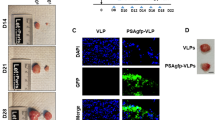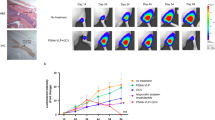Abstract
Overexpression of vascular endothelial growth factor (VEGF) and its cognate receptor KDR has been linked to a more aggressive phenotype of human prostate carcinomas. The importance of signal transduction through the VEGF receptor 2 is illustrated by use of soluble KDR, which binds to VEGF and sequesters this ligand before its binding to cellular receptor. Treatment with recombinant adenovirus AdVEGF-sKDR, encoding sKDR under control of the human VEGF promoter, significantly inhibited the proliferation of human vascular endothelial cells and prostate cancer cells. AdVEGF-sKDR infection decreased migration of endothelial 1P-1B cells (61% reduction) and DU145 prostate carcinoma cells (47%) in comparison with AdCMV-Luc-infected control cells. Ionizing radiation upregulated VEGF promoter activity in prostate carcinoma and endothelial cells. AdVEGF-sKDR infection significantly reduced human vascular endothelial and prostate cancer cell proliferation and sensitized cancer cells to ionizing radiation. In vivo tumor therapy studies demonstrated significant inhibition of DU145 tumor growth in mice that received combined AdVEGF-sKDR infection and ionizing radiation versus AdVEGF-sKDR alone or radiation therapy alone. These results suggest that selective transcriptional targeting of sKDR gene expression employing a radiation inducible promoter can effectively inhibit tumor growth and demonstrate the advantage of combination radiotherapy and gene therapy for the treatment of prostate cancer.
This is a preview of subscription content, access via your institution
Access options
Subscribe to this journal
Receive 12 print issues and online access
$259.00 per year
only $21.58 per issue
Buy this article
- Purchase on Springer Link
- Instant access to full article PDF
Prices may be subject to local taxes which are calculated during checkout






Similar content being viewed by others
References
Martel CL, Gumerlock PH, Meyers FJ, Lara PN . Current strategies in the management of hormone refractory prostate cancer. Cancer Treat Rev 2003; 29: 171–187.
Parker CC, Dearnaley DP . Radical radiotherapy for prostate cancer. Cancer Treat Rev 2003; 29: 161–169.
Teh BS et al. Combining radiotherapy with gene therapy (from the bench to the bedside): a novel treatment strategy for prostate cancer. Oncologist 2002; 7: 458–466.
Kawashita Y et al. Regression of hepatocellular carcinoma in vitro and in vivo by radiosensitizing suicide gene therapy under the inducible and spatial control of radiation. Hum Gene Ther 1999; 10: 1509–1519.
Atkinson G, Hall SJ . Prodrug activation gene therapy and external beam irradiation in the treatment of prostate cancer. Urology 1999; 54: 1098–1104.
Stevens CW, Zeng M, Cerniglia GJ . Ionizing radiation greatly improves gene transfer efficiency in mammalian cells. Hum Gene Ther 1996; 7: 1727–1734.
Zeng M et al. High-efficiency stable gene transfer of adenovirus into mammalian cells using ionizing radiation. Hum Gene Ther 1997; 8: 1025–1032.
Jain PT, Gewirtz DA . Sustained enhancement of liposome-mediated gene delivery and gene expression in human breast tumour cells by ionizing radiation. Int J Radiat Oncol Biol Phys 1999; 75: 217–223.
Folkman J . Angiogenesis in cancer, vascular, rheumatoid, and other disease. Nat Med 1995; 1: 27–31.
Dvorak HF et al. Distribution of vascular permeability factor (vascular endothelial growth factor) in tumors: concentration in tumor blood vessels. J Exp Med 1991; 174: 1275–1278.
Plate KH et al. Up-regulation of vascular endothelial growth factor and its cognate receptors in a rat glioma model of tumor angiogenesis. Cancer Res 1993; 53: 5822–5827.
Ferrer FA et al. Vascular endothelial growth factor (VEGF) expression in human prostate cancer. J Urol 1997; 157: 2329–2333.
Ferrer FA et al. Angiogenesis and prostate cancer: in vivo and in vitro expression of angiogenesis factors by prostate cancer cells. Urology 1998; 51: 161–167.
Shibuya M et al. Nucleotide sequence and expression of a novel human receptor-type tyrosine kinase gene (flt) closely related to the fms family. Oncogene 1990; 5: 519–524.
Terman BI et al. Identification of the KDR tyrosine kinase as a receptor for vascular endothelial cell growth factor. Biochem Biophys Res Commun 1992; 187: 1579–1586.
de Vries C et al. The fms-like tyrosine kinase, a receptor for vascular endothelial growth factor. Science 1992; 255: 989–991.
Waltenberger J et al. Different signal transduction properties of KDR and Flt1, two receptors for vascular endothelial growth factor. J Biol Chem 1994; 269: 26988–26995.
Seetharam L et al. A unique signal transduction from FLT tyrosine kinase, a receptor for vascular endothelial growth factor VEGF. Oncogene 1995; 10: 135–147.
Fong GH, Zhang L, Bryce DM, Peng J . Increased hemangioblast commitment, not vascular disorganization, is the primary defect in flt-1 knock-out mice. Development 1999; 126: 3015–3025.
Terman B et al. VEGF receptor subtypes KDR and FLT1 show different sensitivities to heparin and placenta growth factor. Growth Factors 1994; 11: 187–195.
Clauss M et al. The vascular endothelial growth factor receptor Flt-1 mediates biological activities. Implications for a functional role of placenta growth factor in monocyte activation and chemotaxis. J Biol Chem 1996; 271: 17629–17634.
Soker S et al. Neuropilin-1 is expressed by endothelial and tumor cells as an isoform-specific receptor for vascular endothelial growth factor. Cell 1998; 92: 735–745.
Melnyk O, Zimmerman M, Jin Kim K, Shuman M . Neutralizing anti-vascular endothelial growth factor antibody inhibits further growth of established prostate cancer and metastases in a pre-clinical model. J Urol 1999; 161: 960–963.
Kim KJ et al. Inhibition of vascular endothelial growth factor-induced angiogenesis suppresses tumour growth in vivo. Nature 1993; 362: 841–844.
Kendall RL, Thomas KA . Inhibition of vascular endothelial cell growth factor activity by an endogenously encoded soluble receptor. Proc Natl Acad Sci USA 1993; 90: 10705–10709.
Aiello LP et al. Suppression of retinal neovascularization in vivo by inhibition of vascular endothelial growth factor (VEGF) using soluble VEGF-receptor chimeric proteins. Proc Natl Acad Sci USA 1995; 92: 10457–10461.
Strawn LM et al. Flk-1 as a target for tumor growth inhibition. Cancer Res 1996; 56: 3540–3545.
Collis SJ, Khater K, DeWeese TL . Novel therapeutic strategies in prostate cancer management using gene therapy in combination with radiation therapy. World J Urol 2003; 21: 275–289.
Thurman SA, Ramakrishna NR, DeWeese TL . Radiation therapy for the treatment of locally advanced and metastatic prostate cancer. Hematol Oncol Clin North Am 2001; 15: 423–443.
Weidner N et al. Tumor angiogenesis correlates with metastasis in invasive prostate carcinoma. Am J Pathol 1993; 143: 401–409.
Bettencourt MC et al. CD34 immunohistochemical assessment of angiogenesis as a prognostic marker for prostate cancer recurrence after radical prostatectomy. J Urol 1998; 160: 459–465.
Borre M, Offersen BV, Nerstrom B, Overgaard J . Microvessel density predicts survival in prostate cancer patients subjected to watchful waiting. Br J Cancer 1998; 78: 940–944.
Mydlo JH et al. An analysis of microvessel density, androgen receptor, p53 and HER-2/neu expression and Gleason score in prostate cancer. Preliminary results and therapeutic implications. Eur Urol 1998; 34: 426–432.
Sternberg CN . What's new in the treatment of advanced prostate cancer? Eur J Cancer 2003; 39: 136–146.
Lin P et al. Inhibition of tumor growth by targeting tumor endothelium using a soluble vascular endothelial growth factor receptor. Cell Growth Differ 1998; 9: 49–58.
Leunig M et al. Angiogenesis, microvascular architecture, microhemodynamics, and interstitial fluid pressure during early growth of human adenocarcinoma LS174 T in SCID mice. Cancer Res 1992; 52: 6553–6560.
Goldman C et al. Paracrine expression of a native soluble vascular endothelial growth factor receptor inhibits tumor growth, metastasis, and mortality rat. Proc Natl Acad Sci USA 1998; 95: 8795–8800.
Kendall R, Wang G, DiSalvo J, Thomas K . Specificity of vascular endothelial cell growth factor receptor ligand binding domains. Biochem Biophys Res Commun 1994; 201: 326–330.
Kendall R, Wang G, Thomas K . Identification of a natural soluble form of the vascular endothelial growth factor receptor, FLT-1, and its heterodimerization with KDR. Biochem Biophys Res Commun 1996; 226: 324–328.
Abdollahi A et al. SU5416 and SU6668 attenuate the angiogenic effects of radiation-induced tumor cell growth factor production and amplify the direct anti-endothelial action of radiation in vitro. Cancer Res 2003; 63: 3755–3763.
Park JS et al. Ionizing radiation modulates vascular endothelial growth factor (VEGF) expression through multiple mitogen activated protein kinase dependent pathways. Oncogene 2001; 20: 3266–3280.
Ma BB, Bristow RG, Kim J, Siu LL . Combined-modality treatment of solid tumors using radiotherapy and molecular targeted agents. J Clin Oncol 2003; 21: 2760–2776.
Garcia-Barros M et al. Tumor response to radiotherapy regulated by endothelial cell apoptosis. Science 2003; 300: 1155–1159.
Masood R et al. Vascular endothelial growth factor (VEGF) is an autocrine growth factor for VEGF receptor-positive human tumors. Blood 2001; 98: 1904–1913.
Jackson MW et al. A potential autocrine role for vascular endothelial growth factor in prostate cancer. Cancer Res 2002; 62: 854–859.
Khodarev NN et al. Tumour-endothelium interactions in co-culture: coordinated changes of gene expression profiles and phenotypic properties of endothelial cells. J Cell Sci 2003; 116: 1013–1022.
Vega-Diaz B, Herron GS, Michel S . An autocrine loop mediates expression of vascular endothelial growth factor in human dermal microvascular endothelial cells. J Invest Dermatol 2001; 116: 525–530.
Milanini J et al. p42/p44 MAP kinase module plays a key role in the transcriptional regulation of the vascular endothelial growth factor gene in fibroblasts. J Biol Chem 1998; 273: 18165–18172.
Seko Y et al. Vascular endothelial growth factor (VEGF) activates Raf-1, mitogen-activated protein (MAP) kinases, and S6 kinase (p90rsk) in cultured rat cardiac myocytes. J Cell Physiol 1998; 175: 239–246.
Mahasreshti PJ et al. Intravenous delivery of adenovirus-mediated soluble FLT-1 results in liver toxicity. Clin Cancer Res 2003; 9: 2701–2710.
Ng IO et al. Microvessel density, vascular endothelial growth factor and its receptors Flt-1 and Flk-1/KDR in hepatocellular carcinoma. Am J Clin Pathol 2001; 116: 838–845.
Zhao J et al. Vascular endothelial growth factor expression in serum of patients with hepatocellular carcinoma. Chin Med J (Engl) 2003; 116: 772–776.
Shi B, Wang X, Yang Z . Vascular endothelial growth factors and liver diseases. Hepatogastroenterology 2001; 48: 1145–1148.
Kaliberov SA et al. Adenovirus-mediated transfer of BAX driven by the vascular endothelial growth factor promoter induces apoptosis in lung cancer cells. Mol Ther 2002; 6: 190–198.
Acknowledgements
We thank Sally B Lagan and Soneshia LM McMillan for assistance in preparing the manuscript.
Author information
Authors and Affiliations
Rights and permissions
About this article
Cite this article
Kaliberov, S., Kaliberova, L. & Buchsbaum, D. Combined ionizing radiation and sKDR gene delivery for treatment of prostate carcinomas. Gene Ther 12, 407–417 (2005). https://doi.org/10.1038/sj.gt.3302432
Received:
Accepted:
Published:
Issue Date:
DOI: https://doi.org/10.1038/sj.gt.3302432
Keywords
This article is cited by
-
Emerging roles of radioresistance in prostate cancer metastasis and radiation therapy
Cancer and Metastasis Reviews (2014)
-
Radiosensitization in prostate cancer: mechanisms and targets
BMC Urology (2013)
-
Inhibitory effect of Bifidobacterium infantis-mediated sKDR prokaryotic expression system on angiogenesis and growth of Lewis lung cancer in mice
BMC Cancer (2012)
-
Enhanced effects of TRAIL-endostatin-based double-gene-radiotherapy on suppressing growth, promoting apoptosis and inducing cell cycle arrest in vascular endothelial cells
Journal of Huazhong University of Science and Technology [Medical Sciences] (2012)
-
Double suicide genes selectively kill human umbilical vein endothelial cells
Virology Journal (2011)



